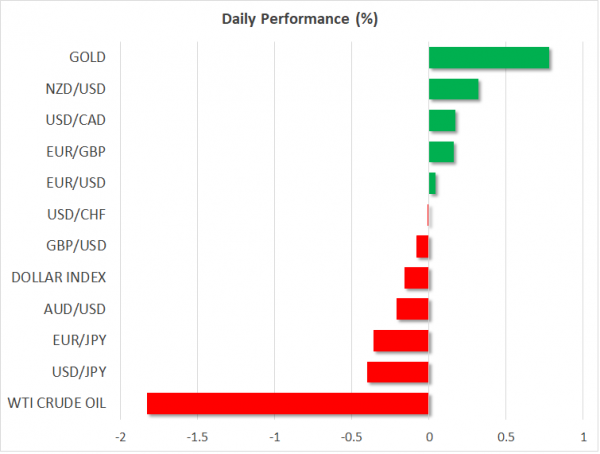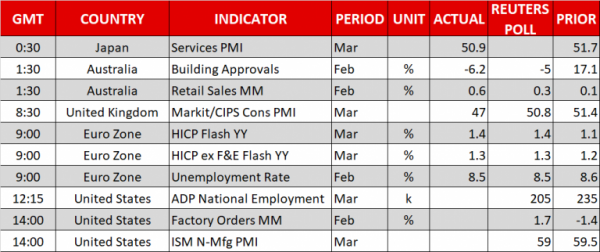FOREX: The US dollar index – which measures the greenback’s performance against six major currencies – dipped by 0.17% on Wednesday and safe-havens jumped once again after China took further trade retaliatory measures against the US today, imposing a 25% import tariff on key US products. Dollar/yen dropped to a session low of 105.98 before it inched up to 106.09, losing 0.43% on the day. Euro/dollar was trading higher by 0.08% during today’s European session and was last seen slightly below the 1.2300 psychological level. Eurozone’s headline CPI released earlier today matched expectations, rising from 1.1% y/y to 1.4% y/y in February. The core measure, though, remained unchanged at 1.0%, below the 1.1% forecast. Pound/dollar slipped by 0.04% to 1.4050 and was on track to post the fourth green day in a row. Aussie/dollar fell by 0.20% to 0.7668, while kiwi/dollar moved higher by 0.37% to 0.7284. Dollar/loonie pared some of Tuesday’s losses after it touched a more than a one-month low of 1.2774 today, being up by 0.19%.
STOCKS: European stocks dipped sharply on Wednesday. The benchmark European STOXX 600 tumbled by 0.78% for the second day in a row. The blue-chip Euro STOXX 50 was down by 0.87%, while the German DAX 30 tumbled by 1.23%, the largest fall in more than a week. The French CAC 40 dived by 0.59%, the Spanish IBEX 35 slipped by 0.82% and the British FTSE 100 declined by 0.41%. In Asia, Japan’s Nikkei 225 and Topix edged marginally higher by 0.13% and 0.14% respectively. In the US, even though the S&P, Dow Jones and the Nasdaq all surged yesterday, futures tracking these indices are currently in the red, pointing to a lower open today.
COMMODITIES: Oil prices slipped on Wednesday as the trade dispute between the US and China escalated, while investors were also concerned about rising US oil production. WTI crude oil plummeted by 1.83%, reaching a new two-week low of $62.35/barrel, while Brent crude plunged by 1.73% below $67.00/barrel. In precious metals, gold prices rebounded from one-week lows touched today, rising by 0.79% to $1,343.6/ounce.
Day ahead: US ADP employment report, factory orders eyed; trade risks intensify
Later in the day, US data will be in focus, with investors keeping a close eye on the ADP national employment report (1215 GMT) which tends to give an early indication of employment trends in the US ahead of the government’s nonfarm payrolls report (NFP) due on Friday. Particularly, the print is expected to show that positions in the private sector grew by 205,000 in March compared to 235,000 seen in February.
Separately, US factory orders due at 1400 GMT are anticipated to return to growth in February, rising by 1.7% in monthly terms after falling by 1.4% in the previous month, while at the same time, the US non-manufacturing PMI for the month of March is said to slow down by 0.5 points to 59.0. Note that, on Monday the ISM manufacturing PMI missed forecasts, retreating from 60.8 to 59.3.
In energy markets, the Energy Information Administration will publish its report on US oil inventories for the week ending March 30, with analysts expecting crude oil inventories to grow for the second straight week. Yesterday, the American Petroleum Institute indicated a drop in US oil stocks, surprising analysts who believed that the measure will continue to increase.
As for today’s, public appearances, St. Louis Fed President James Bullard (non-voter) will be making comments at 1345 GMT before a speech by FOMC board member and Cleveland Fed President Loretta Mester at 1500 GMT.
Trade headlines during the day will be of greater interest as China and the US continue the tit-for-tat game bringing more headaches to investors. A few hours ago, China decided to levy a 25% import tariff on 106 US products amounting to $50 billion per year – the products include soybeans, automobiles, and chemicals. This came just a day after the US unveiled a set of tariffs on Chinese imports.














